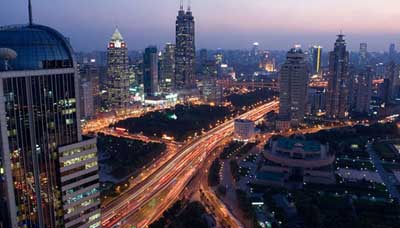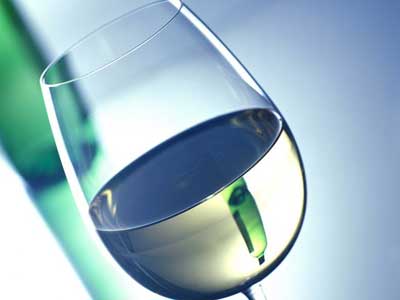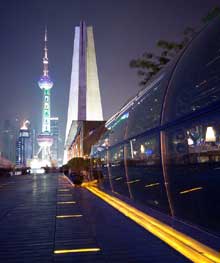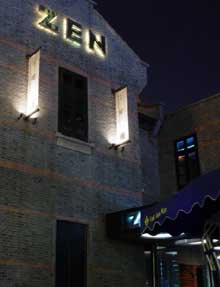On a cool autumn night, Shanghai is drenched in light. Billboards are flashing, highway lights are pulsing, and tall buildings seem to have been converted into giant television screens. China's showcase city appears to be showing off, decorating itself as though it's Asia's Las Vegas. This is China's financial capital, its fashion center and, clearly, its coolest metropolis. Be prepared for a city on steroids, and one banking on long-term hyper-growth. In a country increasingly populated by grimy, characterless cities, Shanghai is also far and away China's most attractive city, particularly after nightfall.
Friday
6 p.m.
1) A WALK ALONG THE BUND
The most spectacular view of Shanghai can be seen at night from the Bund, a historic waterfront area that sits on the west bank of the Huangpu River. Hulking stone structures built in the 1920's and 30's by the colonial powers that once dominated this city have been handsomely renovated and transformed into upscale bars, restaurants and retailers. Walk along the promenade and look out across the river toward the city's booming financial district, Pudong, which is packed with futuristic skyscrapers and flashy neon-lit billboards. The Hongkong and Shanghai Banking Corporation, now known as HSBC, once had headquarters on the Bund, and the building's foyer at No. 12 is gorgeously restored with murals and carvings. Also notable are the Custom House and the Art Deco Peace Hotel (20 Nanjing Road East, 86-21-6321-6888). A building known as Three on the Bund, however, is in perhaps the city's most impressive location (86-21-6321-7733). The interior was elegantly redesigned by Michael Graves. On the ground level is Giorgio Armani. On the third floor is the hip Shanghai Gallery of Art, where one gets a nice view of the building's splendid atrium.
8 p.m.
2) RESTAURANT ON RESTAURANT
A nice way to start off a trip to Shanghai is with dinner at Laris, one of the superb restaurants at Three on the Bund. It is decorated in soothing colors and cool marble. From your table, you can often catch a glimpse of the river and Pudong's space-age skyline. The chef, David Laris, who is Australian Greek, likes fresh ingredients and international flavors. He serves up some wonderful raw oysters; also try the sumptuous beef tenderloin with pancetta and the foie gras terrine with porcini mushrooms (dinner for two, about 790 yuan, or $100 at 8 yuan to $1). On the building's fifth floor is the Whampoa Club, whose Art Deco entrance with a touch of Asia is exquisite. Another winner is Jean Georges Shanghai, the restaurant on the fourth floor named for its creator, the internationally recognized chef Jean-Georges Vongerichten. You can also visit the top floor and New Heights, which has outdoor seating for dinner or simply drinks.
10:30 p.m.
3) A BAR NAMED GLAMOUR
You don't have to leave the Bund to find a great bar and lounge. Across the street from Three on the Bund is No. 5 on the Bund (entrance on Guangdong Road), home to M on the Bund, a popular dining spot for foreign visitors and China's nouveau riche. On the sixth floor, the Glamour Bar is one of the best places in the city to relax with a drink. The lounge (86-21-6350-9988) has a 1930's style decoration with a hip, contemporary twist. Try the litchi martini for about 67 yuan. Just down the road, at No. 18 on the Bund, is Bar Rouge, another stylish fashion bar, often crowded with China's equivalent of the Hollywood set.
Saturday
10 a.m.
4) PUDONG: THE NEW CHINA
Back in the 1980's, Pudong was a muddy tract of farmland across the river from downtown Shanghai. But in 1990, it was declared a special economic zone. Today, it's the fastest-growing part of the city and home to a dazzling new financial district. It also has the city's most compelling and quirky skyline. Two of China's tallest structures are here: the Oriental Pearl Tower -- a tacky concrete pole that at more than 1,500 feet is the tallest TV tower in Asia -- and the nearly 1,380-foot Jin Mao Tower, the tallest building in China and one of the most attractive skyscrapers in the world. Both are fine places for a scenic view of Shanghai's awesome real estate building boom. Going up on the southeast side of the Jin Mao is Shanghai World Financial Center, which is to be completed in 2007 and expected to challenge Taipei 101 in Taiwan as the world's tallest building. The new addition to the Shangri-La Hotel (33 Fucheng Road, 86-21-6882-8888) is also a good place for a scenic view, and it has a great bar and an elegant restaurant, Jade on 36, which features a deconstructed rice bowl entryway and glass snuff bottle decorations. The view after dark is just as spectacular. Also of note in Pudong is the new $125 million Shanghai Oriental Art Center, which was designed by the French architect Paul Andreu and, they say, is meant to look like a butterfly orchid blooming in a large glass bowl. The center has three large performance spaces, with the lobby, chamber music hall, concert hall, exhibition hall and opera hall each occupying one of the petals of the orchid.
Noon
5) THE FRENCH CONCESSION
Much of the charm of Shanghai lies in the old streets and neighborhoods that make up the former French Concession. While many of Shanghai's old lane houses are being bulldozed to make way for often ugly high-rise apartment complexes, this district is filled with leafy lanes and Western-style mansions and gardens. Huaihai Road and Maoming Road are populated with trendy boutiques. Several good options for lunch include Shintori, an excellent Japanese restaurant (803 Julu Road by Fumin Road, 86-21-5404-5252) set in a warehouse with a shimmering gray interior, with lunch at 350 yuan weekdays, 70 prix fixe on weekends, or Yin, which offers Chinese on the first floor and Japanese upstairs (Old Jin Jiang Hotel Gate No. 2, No. 59 Maoming Road South, 86-21-5466-5070); 100 yuan for lunch. It's part of the Old Jin Jiang Hotel, the Art Deco-style complex where Richard M. Nixon and Zhou Enlai signed the "Shanghai Communiqu" in 1972, an important document that helped re-establish diplomatic relations between the two countries.
4 p.m.
6) AN ART OF ITS OWN
Chinese contemporary art is booming. And while much of it is centered in Beijing, Shanghai is developing its own art district, fashioning cool studios and galleries out of old warehouses and textile mills. The new arts district here is called M50, or 50 Moganshan Road. The area is not easy to find, but M50 is definitely worth a visit. Some of Shanghai's best-known artists work here, like Zhou Tiehai, Gu Wenda, Wang Xingwei and Ding Yi. The most interesting gallery shows are held at ShanghART's H-Space (50 Moganshan Road, Building 18, 86-21-6359-3923). Also, take a peek inside Art Scene Warehouse (Building 4, 2/F, 86-21-6277-4940), which has a large and varied collection of works on display. Or simply wander into the open art studios. Shanghai's two art museums, both in the People's Square area, are also worth a visit: the Shanghai Art Museum (which this year is host of the Shanghai Biennale to Nov. 5) at 325 Nanjing Road West (86-21-6327-2829) and the Museum of Contemporary Art at 231 Nanjing Road West (86-21-6327-1282), tucked away in a park and housed in a remodeled greenhouse.
8 p.m.
7) NEW FROM OLD
Xintiandi means new "heaven and earth" and it's the name of one of Shanghai's most popular tourist spots. Pronounced shin-tyahn-DEE, this area of upscale restaurants, bars and boutiques is prized because it's part Disney, part old Shanghai and part Faneuil Hall in Boston. An American architectural firm, Wood & Zapata, splendidly renovated and recreated a district of old Shikumen lane houses the early-20th-century stone-and-brick edifices that were a blend of European and Chinese architectural styles. While the area is small, and often crowded, it's now a must-see in Shanghai. Some of the city's best dining spots are here. Try T8 (8 North Block, Xintiandi, Lane 181, Taicang Road, 86-21-6355-8999); meal for two, from 1,580 yuan. Or, for some of the best Chinese food in town, head to Shanghai Ye (338 Huang Pi Nan Lu, House 6 Xintiandi, by Taicang Road, 86-21-6311-2323); dinner for two, 600 yuan.
10 p.m.
8) DRINKS ON THE OPIUM BED
Finish up your last night in Shanghai by visiting another set of great night spots. Face is one of the most impressive (118 Rui Jin 2 Road, Building 4, Rui Jin Guest House, 86-21-6466-4328). Set in a colonial villa, Face has a bar stocked with cool designs, Asian antiques and even an opium bed where couples can relax with a drink. And if you don't easily tire, take a taxi to South Beauty 881 (881 Central Yanan Road, 86-21-6247-1581), a spicy Sichuan and Cantonese restaurant with bar and lounge connected to an old French mansion. But one of my favorite spots is a little-known place called the Door (1468 Hongqiao Road, third floor; 86-21-6295-3737), which offers an hourlong musical performance beginning at 10 every night but Sunday. The nine-member band plays modern folk music fused with Western styles. They perform using Western and traditional Chinese instruments, like the erhu and the pipa. There's also a short Beijing Opera performance. The interior design -- which makes stylish use of antiques -- is about as good as it gets in Shanghai.
Sunday
9 a.m.
9) THE WAY THEY WERE
A nice place to go to pick up some gifts and souvenirs in Shanghai is the Dongtai Road antiques lanes. Walking through the area will also offer a glimpse of the way some residents continue to live, in crowded apartments, often without indoor plumbing or cooking facilities. The items for sale might include jewelry boxes with Qing dynasty imprints on them, Mao watches, Cultural Revolution-era posters, old coins, books, statues and porcelain. Be prepared to bargain and assume that very little is authentic.
10:30 a.m.
10) BACK FOR BRUNCH
Finish your weekend off by going back to the old French Concession area for brunch at Azul, a tapas restaurant that offers one of the best Western breakfasts in town (18 Dongping Road, near Wulumuqi Road, 86-21-6433-1172). Try the 119-yuan brunch set menu, which will allow you to choose a fresh baby spinach salad, an omelet with basil, sun-dried tomatoes, goat cheese and asparagus, or blueberry pancakes.
The Basics
Shanghai is served by two airports, Hongqiao, which is a 20-to-30-minute ride from downtown, and Pudong International Airport, which mainly caters to long-distance travelers, a little more than an hour's ride from the city. Flights from New York begin at about $850. Cabs from Pudong generally cost 158 yuan, or $20 at 8 yuan to $1, and there is no tipping. Or you can take the ultrafast maglev train, for 50 yuan but you'll still have to change to a taxi for 40 yuan to get all the way downtown.
The Grand Hyatt (Jin Mao Tower, 88 Century Boulevard, Pudong; 86-21-5049-1234), across the river from downtown, is the city's most spectacular hotel; doubles are 1,850 to 3,400 yuan, or $234 to $430. But it's in Pudong, and while the tunnel is close by, traffic can be a problem. Closer to the center are the Four Seasons Hotel (500 Weihai Road; 86-21-6256-8888; 3,105 yuan) and the JW Marriott Hotel (Tomorrow Square, 399 Nanjing Road West; 86-21-5359-4969; 2,875 yuan). Less expensive is the Donghu Hotel (70 Donghu Road; 86-21-6415-8158; 794 to 1,058 yuan) and the Old Jin Jiang Hotel (59 Mao Ming Road South; 86-21-6258-2582; 1,400 to 1,750 yuan).
(China Daily via New York Times April 23, 2007)







